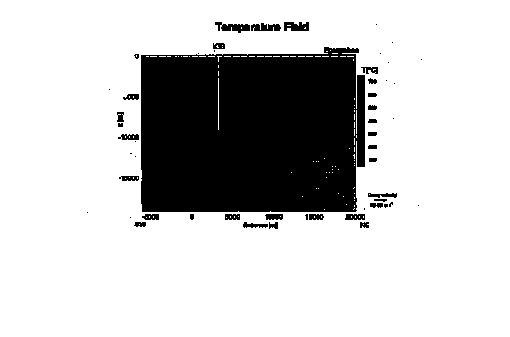
One of the surprising results of the KTB drill site was the measured temperature profile which indicates heat flow above 85 mW m-2, much higher than expected. Extrapolating the measured temperature profile to the Moho by simple 1-D models results in a temperature above 800°C which would call for partial melting of intermediate crustal rocks. These extrapolations contradict the seismic interpretation of the lower crust beneath the KTB (Clauser et al., 1994). This discrepancy can only be explained by additional crustal heat sources. In our approach the effects originating from the Eger Graben are investigated by means of a crustal model of the KTB surroundings, incorporating results of actual geophysical interpretations and especially of gas-geochemical measurements.
The Eger Graben (25 km NE of the KTB) represents a young tectonic perturbation which led to subrecent volcanism. Measurements indicate the age of the youngest volcanic event between 860 and 260 Ka BP (Kopecky, 1986; S˜ibrava and Havlicek, 1980). These nearest events to the KTB (about 28 km East of KTB) represent the latest manifestations of several episodes that started in early Miocene with the strongest activity some 25-20 Ma ago. An indication on actually occurring thermal perturbation is also given by a large gravimetric anomaly S of Eger Graben which can be explained by a high density (magmatic?) body situated in the upper mantle (Behr et al., 1994)
The importance of the Eger-Graben is highlighted by recent gas-geochemical investigations performed around the German-Czech border. The KTB location and the main gas exhalation zones in the western part of the Eger Graben are included in the investigation area. Field investigations and gas analyses showed that large fractions of mantle derived helium (3He/4He ratio) correlate to the CO2 gas flow. The mean CO2 gas flux (taking into account dissolved and free gas) leaving the surface in 1x1 km squares is shown in Fig. 1. The logarithmically scaled isolines prevent the lower values from being suppressed. This gas expulsion correlates well with the seismic interpretation and thus points to the importance of the Eger Graben tectonics to the geothermal situation at the KTB site.
To elucidate the thermal influence of the Eger Graben a coupled heat and mass transport model of the crust with 3-D permeability distribution was set-up. It contains especially a 2-4 km thick zone of increased permeability in the mid crust and a regional heat source below the S part of the Eger Graben. The model shows clearly the development of convection cells which could convey heat to the KTB site. Model parameters were varied in a limited range to fit the available thermal data and by gas flow measurements. Different model assumptions are discussed that allow to evaluate the influence of Eger Graben anomalies to the KTB site.
Behr, H.J., Dürbaum, H.J., Bankwitz, P., Bankwitz, E., Benek, R., Brause, H., Conrad, W., Förster, K., Frischbutter, A., Gebrande, H., Giese, P., Göthe, W., Gürtler, J., Hänig, D., Haupt, M., Heinrichs, T., Horst, W., Hurtig, E., Kämpf, H., Kramer, W., Krentz, O., Trezebski, R., Zeitschrift für Geologische Wissenschaften 22(6) (1994).
Clauser, C., Harms, U., Huenges, E., Kohl, T., Lehmann, H. & Rybach, L., KTB Report 94-2, A117-A128 (1994).
Kopecky, L., Proc. of the 6th Intern. Conf. on Basement Tectonics, 114-124 (1986).
S˜ibrava, V. & Havlicek, P., Bulletin of the Geological Survey, Prague 55(3), 129-140 (1980).
Fig. 1: Quantitative determination of CO2 gas flux in the realm of KTB and western Eger Graben. 
Fig. 2: 2-D simulation of an underground convection system assuming a permeability of 10-17m2 in a depth of 14-19 km.